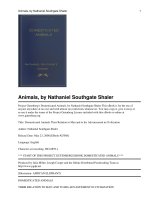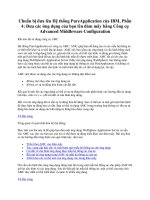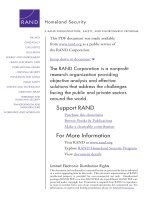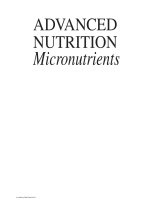T-03 ADVANCED: DIVERSE ANIMALS pot
Bạn đang xem bản rút gọn của tài liệu. Xem và tải ngay bản đầy đủ của tài liệu tại đây (1.96 MB, 15 trang )
Brenda Hoddinott
T-03 ADVANCED: DIVERSE ANIMALS
In this project, you first establish accurate proportions and outline the various shapes and forms
of an adorable young owl named Hooter; you then use graduated hatching techniques to
characterize the various textures and define the forms.
This project is divided into the following two sections:
PUTTING PROPORTIONS ON PAPER: You examine the structures of a wing and
feather, and then sketch the proportions of the owl. While the structures of feathers and
wings are very complex, drawing realistic looking birds is not difficult.
ADDING SHADING AND TEXTURE: You use hatching to add values to the body to
represent the texture of feathers. The hatching lines used to draw feathers are ragged and
uneven with lines of various lengths and thicknesses. Finally, you draw the details of the
eyes and add a wood texture to the tree branch.
Suggested drawing supplies include good quality white drawing paper, kneaded and vinyl
erasers, and various graphite pencils such as 2H, 2B, HB, 4B, and 6B.
15 PAGES - 23 ILLUSTRATIONS
This project is recommended for artists, aged twelve to ninety-nine, who have good drawing
skills, and also for home schooling, academic and recreational fine art educators.
Published by Hoddinott Fine Art Publishers, Halifax, NS, Canada, Revised 2006
Copyright to all articles, images, text, projects, lessons and exercises within this drawing class belong to Brenda Hoddinott and
may not be reproduced or used for any commercial purposes whatsoever without the written permission of Brenda Hoddinott.
E-mail Web site or
2
PUTTING PROPORTIONS ON PAPER
While the structures of feathers and wings are very complex, drawing realistic looking birds is
not difficult. You begin this project by examining the structures of feathers and a wing, and
sketching the proportions of the owl.
A basic understanding of the anatomy of a wing and feathers is very helpful if you run into
problems trying to accurately render a drawing of a bird. The next two drawings show the basic
construction of a feather. The long skinny thing down the center of the feather is called a shaft
and the wide end is referred to as a quill. Many years ago writers would dip the quill end (which
has a hollow center) into ink, thereby transforming the feather into a pen.
ILLUSTRATION 3-01 ILLUSTRATION 3-02
Feathers differ in size and texture depending on where they are located on the bird’s body. The
following words describe the various types of feathers:
Tiny, soft, and downy feathers are located on his head, chest and feet.
Medium-sized, soft, and short feathers, with narrow quills, are generally found on the
upper section of the wing.
Long and firm, but relatively soft to the touch feathers, with wide quills and noticeable
shafts, make up the middle and lower sections of the wings.
ILLUSTRATION 3-03
This drawing shows
the basic construction
of a wing.
While I established
this schematic for a
drawing I was doing
of an angel, the basic
wing structure is similar
to that of various types of
birds from a tiny delicate
Humming Bird to a magnificent
Bald Eagle.
Copyright to all articles, images, text, projects, lessons and exercises within this drawing class belong to Brenda Hoddinott and
may not be reproduced or used for any commercial purposes whatsoever without the written permission of Brenda Hoddinott.
E-mail Web site or
3
Sketching accurate proportions is the foundation of realistic drawing. Proportion is the
relationship in size of one component of a drawing to another or others. If the proportions are
off, no amount of beautiful shading or fancy pencil marks can save your drawing.
My drawing is tiny (6 by 7 inches), but you may prefer try a larger drawing format such as 9 by
12, or 12 by 14 inches. Drawing format refers to the area of a drawing surface within a specific
perimeter, outlined by a shape of any size, such as the page of a sketchbook.
ILLUSTRATION 3-04
1) Lightly sketch an egg-shape for the owl’s body, tilted
slightly toward the left of your drawing space.
Here’s proof that the egg came first! (Grin) Don’t press too
hard with your pencil. You need to erase these lines later.
Make sure you leave room to later add the owl’s head, the
wing to the right, and the feet and tree branch below.
ILLUSTRATION 3-05
2) Draw a horizontal
oval (the head) that
overlaps the body.
ILLUSTRATION 3-06
3) Add a wing that
extends from the
bottom of his head at
an angle toward the
lower right.
Take note of the following:
The overall shape of the wing appears to
be an upside-down elongated teardrop.
The wing seems to point toward the
lower right corner with its tip.
The wing becomes gradually narrower
until it finally ends in a slightly rounded
point.
Copyright to all articles, images, text, projects, lessons and exercises within this drawing class belong to Brenda Hoddinott and
may not be reproduced or used for any commercial purposes whatsoever without the written permission of Brenda Hoddinott.
E-mail Web site or
4
ILLUSTRATION 3-07
4) Draw a V-shape on the
face with curved lines at
the top of each side of
the V.
The lower tip of the V-
shape will be the beak of
the owl and the outward
curves extending from the
top of each side of the V
represent the upper
sections of the eyes.
5) Add a small upside-down
U-shape above the tip of the
beak.
Refer to the drawing below.
ILLUSTRATION 3-08
6) Sketch a few fluffy feathers
under the wing.
7) Add two oval shapes to
represent the feet.
Observe that the foot on the right
appears to be much larger than
the other. However, in real life
when viewing an owl from the
front, both feet would be the
same size.
In that this foot is closer to the
viewer, perspective dictates that
it needs to be drawn bigger than
the one farther away.
Copyright to all articles, images, text, projects, lessons and exercises within this drawing class belong to Brenda Hoddinott and
may not be reproduced or used for any commercial purposes whatsoever without the written permission of Brenda Hoddinott.
E-mail Web site or
5
ILLUSTRATION 3-09
8) Outline the owl’s eyes.
Note that the eyes appear as partial circles
because the inside center section of each is
hidden behind the feathers between the
eyes. Each is a partial large circle with a
smaller circle inside.
9) Add an angular branch of a tree for the
owl to sit on.
Double check the
proportions of your
sketch before you
begin shading, by
visually measuring the
shapes of the positive
and negative spaces.
Observe the lengths,
angles, and curves of
the various lines which
outline the owl and the
tree branch.
ADDING SHADING AND TEXTURE
You begin this section of the project by adding values to the body with hatching lines. You then
add the texture of feathers, draw the details of the eyes, and add a realistic wood texture to the
tree branch.
The hatching lines used to draw feathers are ragged and uneven with lines of various lengths and
thicknesses. While some hatching lines are dark and others are light, you still need to maintain an
overall difference of values from light to dark. Assume that the light source in this drawing is
from the upper left. Subsequently the overall values on the left will be lighter than on the right.
Have another look at the drawing of the wing (Illustration 3-03). Observe that the feathers are in
layers with the shortest feathers close to the body. The feathers become progressively longer
with the thinner, more defined feathers being on the tips of the wing.
Copyright to all articles, images, text, projects, lessons and exercises within this drawing class belong to Brenda Hoddinott and
may not be reproduced or used for any commercial purposes whatsoever without the written permission of Brenda Hoddinott.
E-mail Web site or
6
10) Lighten your outline by gently patting the lines with your kneaded eraser.
11) Replace the rough sketch lines of the owl’s head, body and feet with ragged fuzzy lines
to represent the texture of feathers.
12) Redraw the edges of the tree branch so it looks rugged and uneven.
ILLUSTRATION 3-10
Keep in mind that
a full range of
values gives
contrast between
the light and the
shadow areas.
Remember,
light affects
the placement
and value of
every section
of shading.
The light source is
from the left in this
drawing, so the
shading will be a
little darker on the
right.
Copyright to all articles, images, text, projects, lessons and exercises within this drawing class belong to Brenda Hoddinott and
may not be reproduced or used for any commercial purposes whatsoever without the written permission of Brenda Hoddinott.
E-mail Web site or
7
13) Add curved hatching lines to the head to represent small, soft feathers.
Watch very closely the different directions in which the hatching lines curve. Take your
time. The directions in which the hatching lines curve are important, because they help give
the illusion of depth to the various forms.
ILLUSTRATION 3-11
14) Draw some slightly curved
hatching lines on the owl’s
breast to represent spots.
15) Outline feathers of different
shapes and sizes on the
wing.
Note that the feathers are
considerably shorter in the
upper section closer to the
head than toward the tips of
the wings.
16) Add a few curved
hatching lines on
the feet to indicate
the direction in
which the tiny soft
feathers grow.
Copyright to all articles, images, text, projects, lessons and exercises within this drawing class belong to Brenda Hoddinott and
may not be reproduced or used for any commercial purposes whatsoever without the written permission of Brenda Hoddinott.
E-mail Web site or
8
Remember, the hatching lines used for drawing feathers, are
several different lengths and values. The edges are not abrupt stops, but rather
feathered (or ragged) to give a more realistic appearance.
ILLUSTRATION 3-12
17) With your 2H pencil, lightly
shade in the feathers on the left
and center sections of his feet
and lower body.
18) Use your 2B pencil to shade in
the medium values, mostly on
the right.
Remember, the light source is
coming from the left. The
feathers on the right are darker
than on the left.
19) Add the dark values
of his feathers on his
lower body, his
shoulder under his
head (on the right),
and under his beak
and wing with a 2B
or 4B pencil.
20) Add
another
circle
around
the
perimeter
of the
irises as
the rims
of the
eyes.
Copyright to all articles, images, text, projects, lessons and exercises within this drawing class belong to Brenda Hoddinott and
may not be reproduced or used for any commercial purposes whatsoever without the written permission of Brenda Hoddinott.
E-mail Web site or
9
ILLUSTRATION 3-13
21) Add shading to the
outer rims of the eyes
with a 2B.
22) Complete the outlines
of the eyes by adding a
tiny highlight in the
upper left of the eye
on the left.
Refer to the drawing
below.
ILLUSTRATION 3-14
23) Use your 6B pencil to
shade in the dark
values of the pupils.
24) Add a long narrow
raggedy section of
dark shading to the
beak (on the right).
ILLUSTRATION 3-15
25) Shade the lower section
of each iris with a 2H,
and the top sections
with an HB.
26) Complete the shading of
his beak with squirkles.
Leave a long thin
highlight in the center,
and a light section on the
lower right edge of his
beak (reflected light).
Copyright to all articles, images, text, projects, lessons and exercises within this drawing class belong to Brenda Hoddinott and
may not be reproduced or used for any commercial purposes whatsoever without the written permission of Brenda Hoddinott.
E-mail Web site or
10
ILLUSTRATION 3-16
27) Use very sharp
pencils to add
more hatching
lines to all
sections of the
head.
Use a 2H for light
sections and 2B
and 4B for the
darker areas.
Note the darkest
shading in the
shadow areas,
such as the upper
part of his eye and
on the side of his
beak.
ILLUSTRATION 3-17
28) Add a few tiny
oval shapes
throughout the
feathers on the
upper sections
and along the
sides of Hooter’s
head.
This illustration
shows a close up
view of these tiny
ovals. If you want
to make a few of
them stand out
more, simply
mold your
kneaded eraser to
a point and lighten
the center sections
of each.
Copyright to all articles, images, text, projects, lessons and exercises within this drawing class belong to Brenda Hoddinott and
may not be reproduced or used for any commercial purposes whatsoever without the written permission of Brenda Hoddinott.
E-mail Web site or
11
29) Use a freshly sharpened pencil and short hatching lines to draw the soft downy
feathers on Hooter’s chest and feet.
ILLUSTRATION 3-18
Don’t miss the sections
of dark values on the
upper chest that look
like spots.
30) Add shading to the tail
feathers.
Refer to the drawing
below. Tail feathers are
large and can be well
defined with textured
shading. The values of
each are very dark on
the right and graduate
to light. The lightest
section of each is on the
far left.
31) Add a few angular
lines on some of the
feathers.
ILLUSTRATION 3-19
As you can
see by
looking
closely at
my drawing,
a few
angular lines
drawn on
each feather
completes
the shading
and
emphasizes
the fine
details.
Copyright to all articles, images, text, projects, lessons and exercises within this drawing class belong to Brenda Hoddinott and
may not be reproduced or used for any commercial purposes whatsoever without the written permission of Brenda Hoddinott.
E-mail Web site or
12
ILLUSTRATION 3-20
32) Add shading to the
feathers on the upper
section of the wing.
Observe that the shading
is lighter closer to the left
and gradually becomes
darker toward the right.
Also take note of the
very dark shading on
the upper section next
to his head. This is
caused by the head
casting a shadow onto
the body.
Copyright to all articles, images, text, projects, lessons and exercises within this drawing class belong to Brenda Hoddinott and
may not be reproduced or used for any commercial purposes whatsoever without the written permission of Brenda Hoddinott.
E-mail Web site or
13
33) Use various pencils and hatching lines to bring out the texture of the feathers on the
upper section of the wing.
Note that some sections are left very light to create the illusion that a few of the feathers are
very light on the tips.
ILLUSTRATION 3-21
34) Add shading to his talons on the ends of his toes.
35) Use a combination of hatching and squirkling to add shading and texture to the
branch of the tree.
Take note that the shading is lighter toward each end.
ILLUSTRATION 3-22
Copyright to all articles, images, text, projects, lessons and exercises within this drawing class belong to Brenda Hoddinott and
may not be reproduced or used for any commercial purposes whatsoever without the written permission of Brenda Hoddinott.
E-mail Web site or
14
ILLUSTRATION 3-23
Add final touches if
needed. You can make
sections of the feathers
lighter by patting them with
your kneaded eraser. You
make areas darker by
simply drawing more
hatching lines where you
need them.
Sign your name and put today’s
date on the back of your
drawing! You have just
completed a major project!
Copyright to all articles, images, text, projects, lessons and exercises within this drawing class belong to Brenda Hoddinott and
may not be reproduced or used for any commercial purposes whatsoever without the written permission of Brenda Hoddinott.
E-mail Web site or
15
BRENDA HODDINOTT - BIOGRAPHY
As a self-educated teacher, visual artist, portraitist, forensic artist, and illustrator, Brenda
Hoddinott utilizes diverse art media including graphite, technical pen, colored pencil, chalk
pastel, charcoal, conté crayon, and oil paints.
My philosophy on teaching art is to focus primarily
on the enjoyment aspects while gently introducing
the technical and academic. Hence, in creating a
passion for the subject matter, the quest for
knowledge also becomes enjoyable.
>Brenda Hoddinott<
Born in St. John’s, Newfoundland, Brenda grew up in the small town of Corner Brook. She
developed strong technical competencies with a personal commitment to self directed learning,
and the aid of assorted “Learn to Draw” books. During Brenda’s twenty-five year career as a
self-educated civilian forensic artist, numerous criminal investigation departments have
employed Brenda’s skills, including Royal Canadian Mounted Police and municipal police
departments. In 1992, Brenda was honored with a commendation from the Royal Canadian
Mounted Police, and in 1994, she was awarded a Certificate of Membership from “Forensic
Artists International”.
Her home-based art career included graphic design, and teaching recreational drawing and
painting classes. As supervisor of her community’s recreational art department, Brenda hired and
trained teachers, and designed curriculum for several children’s art programs. In 1998, Brenda
chose to end her eighteen-year career as an art educator in order to devote more time to writing,
drawing, painting, and developing her websites.
Drawspace incorporates her unique style and innovative approach to
curriculum development. This site offers downloadable and printable drawing classes for
students of all abilities from the age of eight through adult. Students of all ages, levels and
abilities have praised the simple step-by-step instructional approach. This site is respected as a
resource for fine art educators, home schooling programs, and educational facilities throughout
the world.
LEARN-TO-DRAW BOOKS BY BRENDA HODDINOTT
Drawing for Dummies: Wiley Publishing, Inc., New, York, NY, this 336 page book is
available on various websites and in major bookstores internationally. Drawing for Dummies
is now available in Dutch, Bulgarian, Spanish, French, and German.
The Complete Idiot’s Guide to Drawing People: Winner of the Alpha-Penguin Book of the
Year Award 2004, Alpha - Pearson Education – Macmillan, Indianapolis, IN, this 360 page
book is available on various websites and in major bookstores internationally.









